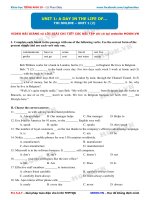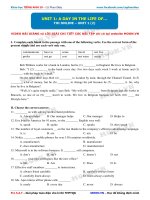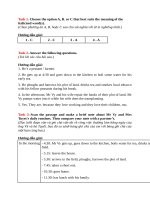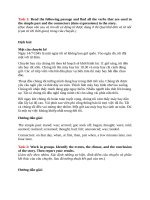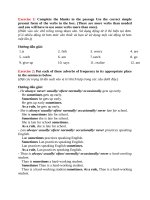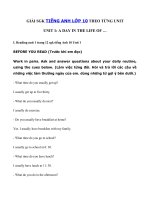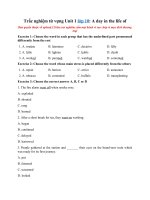unit 1 lop 10
Bạn đang xem bản rút gọn của tài liệu. Xem và tải ngay bản đầy đủ của tài liệu tại đây (90.61 KB, 8 trang )
Period
2:
Unit1: A day in life
of ...
A. Reading
I. Objectives
1. General knowledge: Through the lesson sts will be able to know
more about the
work of a farmer.
2. Skill: +Read and guess the meaning of the words in the context.
+ Scan for for specific information.
II. Methods: - Individual, pairwork, groupwork.
III. Teaching aids: - Textbooks, pictures in the book, posters.
IV. Anticipated problems: Sts may get trouble in understanding some
new words.
V. Procedures:
Teacher’s activities
Students’ activities
Ti
me
1. Warm up:
5’
T hands the paper out and asks sts to Sts work in pairs to match
do the matching ex.
the people with the place
where they work.
1. teacher
a. market
2. doctor
b. school
3. seller
c. hospital
4. worker
d. field
5. farmer
e. factory
2. Before you read:
5’
T asks sts to work in pairs to asks and
Sts work in groups.
answer about their daily routine.
Example: A: What time do you get up?
Sts give their answer.
B: I often get up at six.
Sts pay attention and take
- What time do you go to school/ have
note
breakfast/ lunch/ dinner/
Sts practise reading the
words and phrases.
3. While you read:
T sets the scene: You are going to read Sts listen to the T.
2 passages about 2 farmer. While you
are reading, do the tasks following.
Task 1:
(?) Find the word in the passages that
best suits the meaning of the italicised
word(s).
Sts read the passages in
silence, and do the task 1
individually.
10’
T asks sts to check their answer in
pairs.
T calls some sts to present and explain
their answer.
T gives the right answer: (1C, 2C, 3A,
4A).
Task 2:
T gives instruction: You have to read
the passage again and answer the
questions in the task.
T checks sts’ answer and gives the
right answer.
(1. He is a farmer.
2. He gets up at 4’30and goes down to
the kitchen to boil some water.
3. He ploughs and harrows his plot of
land.
4. They go to the fiels again,
preparethe banks of our plot of land.
5. Yes, they are. Because they love
working.)
Task 3:
T asks sts to read the request of the
task.
T explains how to do the task and asks
sts to do it then compare the answer
with a partner.
T checks sts’ answer
T gives the right answer
In the
-4’30: Mr Vi gets up, goes
morning down the kitchen, boil water
for tea, drink tea
-5’15: leaves house
-5’30; arrives to the field
-7’45: takes a break
-10’30: goes home
In the
-2’30: Mr Vy and Mrs Tuyet
afternoo go to the field again,
n
repairthe baks of the plot of
land. He pumps water into
the plot of land, shedoes the
transplanting.
-6’30: finish work
-7’00 have dinner
After
-watch TV, go to bed
dinner
Sts compare their answer
with a partner.
Sts give their answer
Sts write the right answer
in their notebook.
Sts read the 5 questions
and read the passage
again then answer the
15’
questions.
Sts work individuals then
discuss their answer with
their partners.
Sts give their answer
Sts compare their answer
with the teacher’ and write
the correct answer in their
notebooks.
Sts read the request and
do the task individually
then in pairs.
Sts give their answer.
Sts take note.
4. After you read:
T asks sts to work in groups to talk
about Mr Vy and Mrs Tuyet’s daily
routines.
T calls some sts to check their work.
5. Homework:
(?) Write a paragraph about Mr Vy
and Mrs Tuyet’s daily routines.
Sts work in groups
8’
Sts speak out.
2’
Sts take note and prepare
at home.
* Comments:
....................................................................................................................
....................................................................................................................
....................................................................................................................
....................................................................................................................
........................................................................................................
Period
3:
Unit1: A day in life
of ...
B. Speaking
I. Objectives
1. General knowledge: Through the lesson sts will be able to talk
abouthis or her
daily routine by using given information
and pictures.
2. Skill: + Ask and answer about routine and time table.
+ Talk about daily routine.
II. Methods: - Individual, pairwork, groupwork.
III. Teaching aids: - Textbooks, pictures in the book, posters.
IV. Anticipated problems: Sts may have difficulty in arranging daily
activities in good order for describing
V. Procedures:
Teacher’s activities
Students’ activities
Ti
me
1. Warm up:
5’
Networks
T asks sts to work in groups of 3 or 4 Sts work in groups
and make a list of the subjects they
learn at school.
Sts give their answer.
T chesks sts' answer and finds out the Anticipated answer: Civic
winner (The group with the most words aducation,
Technology,
within a limit time will be the winner).
Maths,
Physics,
Literature,
Biology,
Physical
education,
Geography,
History,
T leads in the new leson
Informatics
2. Task 1:
T sets the scene; Quan is a tenth grade
Sts listen to the T’s
student. He gored to school every
introduction.
morning. Now look at weekly time table
on page 15. Aks and answer questions
with a partner using the infornation from
the time table
Examples:
Sts work in pairss to ask
A: What time does Quan have Civic
and answer questions
education lesson on Monday?
about Quan’s time table.
B: He has Civic education lesson at 7:
15a.m
A: What lessen does Quan have at 7:
15a.m on Monday?
B:Civic education lesson.
3. Task 2
T asks sts to study the pictures carefully
and describe Quan’s activities during the
day.
T goes to different pairs and order help if
necessary.
T gets feedback and gives suggested
answer.
* Everyday Quan gets up at 14’00. Then
he study for 2 hours> He watches TV at
16’30. At 17’00 he rides to stadium to
play football with other boys in the
neighbourhood. He gets back home at
18’00. After having shower, he has
dinner with his family. He prepares for
the following day’s lesson at 20’00.
4. Homework:
(?) Write a paragraph about your own
routine
* Comments:
5’
10’
Sts work in pairs to study
the pictures carefully and
describe Quan’s activities
during the day.
15’
Sts stand up and speak
out.
2’
Sts take note and prepare
at home.
....................................................................................................................
....................................................................................................................
....................................................................................................................
....................................................................................................................
........................................................................................................
Period
4:
Unit1: A day in life
of ...
C. Listening
I. Objectives
1. General knowledge: By the end of the lesson sts will be able to
talk about a day in the life of a cyclo driver; improve listening skill by
doing Picture Ordering and True or False exercises.
2. Skill: + Listening comprehesion about the work of a working
people
+ Listen and do Pictures Ordering and Tru or False
exercises.
II. Methods: - Individual, pairwork, groupwork.
III. Teaching aids: - Textbooks, pictures in the book, posters, tape and
rodio.
IV. Anticipated problems: Sts may not be familiar with the life ofa
cyclo driver.
V. Procedures:
Teacher’s activities
Students’ activities
Ti
me
1. Warm up:
5’
Categorising
T asks sts to work in groups of 3 or 4 Sts work in groups to put
and put the sentences into the correct the sentences into the
column.
correct column.
He’s
a He’s
a He’s a cyclo
farmer
teacher
driver
Sts give their answer.
Anticipated answer:
He’s a farmer
1.4.9
1. He gets up very early.
He’s a teacher
3.6.7
2. He works in the street.
3. He works with the children
He’s
a
cyclo 2.5.8
4. He lives in the coutry.
driver
5. He gets peopke from one place to
another.
6. He corrects homework.
7. He wors in school.
8. He meets alot of peop;e.
9. He works on the farm.
T chesks sts' answer and finds out the
winner
T leads in the new leson
2. Before you listen:
T tells sts to work in pairs to ask and
answer the questions.
T calls some pairs to check their work
T helps sts to study some new words
- district: (n)
passenger ; (n)
- drop: (v)
- office :
(n)
- routine: (n)
- ride : (v)
T leads in he new lesson.
3. While you listen;
T sets the scene; Mr Lam is a cyclo
driverin Ho Chi Minh city. Let’s get his
routine. What does he do in his job?
Task 1:
T asks sts to study the pictures and
listen to Mr Lam’s talk about his daily
routine and number the pictures in
their correct order.
T plays the tape several time if
necessary.
T asks sts tocompare their answer
with a friend.
T gets feedback and gives correct
answers: (a3 b5 c4 d6 e1 f2).
Task 2:
T asks sts to read the statements
carefully.
T play the tape again and asks sts
tolisten and decide whether the
statements are true or false.
T calls some sts to explain their
answers.
T gives the right answer.
1. F (not given)
2. T.
3. F (He takes his passengers from
district 5 to district 1.)
4. F (His first passenger is an old
man)
5. F (He has lunch at a food stall near
Ben Thanh market)
6. He takes a short rest)
4. After you listen:
Sts work in pairss to ask
and answer question.
Sts practise asking and
answering.
Sts pay attention and
take note
Sts practise reading the
new words.
Sts pay attention and
have gueses about Mr
Lam’s routine.
Sts study the pictures
and listen to the tape.
Sts compare their answer
with a friend.
Sts compare their answer
with the T’s.
Sts
to
read
the
statements carefully.
Sts listen to the tape and
do the task in individual
and in pairs.
Sts give their answer.
Sts compare their answer
with the T’s.
5’
T asks sts to work in pairs to ask and
answer about Mr Lam’s activities by
using the cues on page17.
T goes around and offer help if
necssary.
T calls on some pairs to ask and
answer in front of the class.
T gets feedback and gives
suggessted answer.
* What is the man’s name?
What does he do?
What time does he start work?
Who are his passengers?
Where and what time does he have
lunch?
Does he take a rest?
Sts work in pairs toask
and answer about Mr
Lam’s activities.
Sts practise in front of
the class.
Sts pay attention and
take note.
4. Homework:
(?) Write a paragraph about what you Sts take note and prepare
at home.
can remember about Mr Lam.
* Comments:
....................................................................................................................
....................................................................................................................
....................................................................................................................
....................................................................................................................
........................................................................................................
Period
5:
Unit1: A day in life
of ...
D. Writing
I. Objectives
1. General knowledge: By the end of the lesson sts will be able to
write a narrative by using given prompt.
2. Skill: Write a narrative.
II. Methods: - Individual, pairwork, groupwork.
III. Teaching aids: - Textbooks, pictures in the book, posters, tape and
rodio.
IV. Anticipated problems: Sts may not be familiar with the life ofa
cyclo driver.
V. Procedures:
Teacher’s activities
Students’ activities
Ti
me
1. Warm up:
5’
Noughts and crosses
T draws a table containg 9 words in eash
cell.
T devides class into 2 groups; Noughts
(O) and crosses (X)
T asks sts to choose word by word in the
cell and make centences with each
word. a correct sentense gets one O or X
> the group with 3 O or X vertically.
horizontally or even diagonally first willl
be the winner.
At first
Before
until
then
after
As soon as
In the end
while
Since then
2. Task 1.
T helps sts to understand some new
words.
- be due to: because of, owning to
- stare death in the face:
- take off
- air hostess
- fasten seat belt
- be in danger:
T asks sts to work in pairs, read the
passae in the book and find all the verds
that are used in the past simple tense
and the connectors in the story.
T calls some sts to give the verds and
the connectors in front of the class.
T gives suggested answer:
* Verds: started, was, arrived, got, took
off, began, thought, were, told, seemed,
reaalised, screamed, felt.
* Connectors: on that day, at first, then,
just, a few minutes later, one hour later.
Sts pay attention and
play the game in groups.
5’
Sts pay attention
take note.
and
Sts work in pairs, read
the passage in the book
and find all the verds that
are used in the past
simple tense and the
connectors in the story.
Sts give their answer.
Sts pay attention and
take note
3. Task 2:
T explains to sts the format of a
narrative: the events, the climax and
the conclusion.
T asks sts to work in groups and
identify the events, the climax and
the conclusion.
T asks them to report th result to
class.
Sts pay attention.
Sts work in groups, read
the story again and
identify the events, the
climax
and
the
conclusion then report
to the class.
Sts listen to the T.
T gives the right answer and
explainsthe dvelopment of the story.
4. Task 3:
T introduces the task and tells them
to work in dividually, use the prompt
to build up a narrative about hotel
fire.
T goes around and offer help if
necssary.
T asks sts to have peer correction and
pay attention to mistakes regarding
verd tense and preposition.
T calls on some sts to read aloud
their writing in front of the class.
T gives commment and corrects
necessarry mistakes
Sts work in pairs toask
and answer about Mr
Lam’s activities.
Sts read their writing in
front of the class.
Sts pay attention and
take note.
4. Homework:
(?) Write a completed
about hotel fire.
paragraph Sts take note and prepare
at home.
* Comments:
....................................................................................................................
....................................................................................................................
....................................................................................................................
....................................................................................................................
........................................................................................................
Period
6:
Unit1: A day in life
of ...
E. Language focus.
I. Objectives
1. General knowledge: By the end of the lesson sts will be able to
be more confident in pronouncing the sounds /i:/ and /I/ and better at
using the present and past simple tense and adverds of frequency.
2. Skill: Identifying the sounds /i:/ and /I/
Reviewing the present and past simple tense and averds of
frequency.
II. Methods: - Individual, pairwork, groupwork.
III. Teaching aids: - Textbooks, pictures in the book, posters.
IV. Anticipated problems: Sts may not know how to pronounce the
sound /i:/ and /I/ correctly.
V. Procedures:
Teacher’s activities
Students’ activities
Ti
me
1. Warm up:
5’
Categorizing
T gives out 10 to 15 words and tells sts
to put them under approriate heading.
Sts work in groups to put
the
adverbs
under
Adverbs
of
approriate heading.
manner.
Adverbs
of
frequecy
Adverbs of time
Adverbs: tomorrow, usually, carefully,
beautifully, hardly, ever, yesterday.
2. Pronuciation:
T demonstratesthe sounds /i:/ and /I/ by
pronouncing them clearly and slowly.
T instructs the way to pronounce the
sounds:
/i:/: open your mouth very little. /i:/ is a
long sound.
/I/: first practice the sound /i:/ then opn
your mouth a little more. /I/ is a short
sound.
T reads the words and asks sts to
repeat.
T calls some sts to read the words
clearly to the class.
T asks sts to work in pairs to practice the
sentences
3. Grammar and vocabulary:
*Review the simple tense
T asks sts to work in pairs and discuss
the form and use of the present simple
tense.
T calls some sts to answer some
questions :
- When do we usee the present simple
tense?
- What averbs of frequecy does it goes
with/
...
*Exercise 1:
T asks sts to work in dividually and
complete the blank in the passage. Use
the correct form of the verbs in the box.
T asks sts to compare the answer with a
friend.
T calls some sts to read the completed
passage.
T gives the correct answer:
*1.is 2. fish 3.worry 4.are 5. catch
6. am 7. catch 8. go 9. give up 10.
says 11. realise 12. am.
*Execise 2:
T asks sts to do ex 2: Put he verbs in its
correct order in to the sentences in the
book.
T calls some sts to read the sentences to
class.
T get feeback and gives the correct
Sts pay attention
remember.
and
Sts repeat after the T.
Sts read the words loudly
Sts practise reading the
sentences.
Sts review
tense
the
simple
Sts do the ex individually
then compare the answer
with a friend.
Sts read the completed
passage.
Sts pay attention and
take note.
Sts do the ex 2
Sts read their sentences.
Sts pay attention and
take note.
5’
answer:
- He usually gets up early.
- She is nver late for school.
- Lan some time practise speaking
English.
- Thao is always a hard working
student.
*Exercise 3:
T help sts to review the past simple
tense.
Use; We use the past simple tense to
describe a completed sentence or
situation in the past.
Eg: We went to the cinema yesterday.
T asks sts to work in pairs and supply
the correct past simple form of the verds
in the brackets.
T calls some sts to read the completed
passage aloud in front of the class.
T gives the correct answer:
1. was done 2. cooked 3. were 4.
smelt 5. told 6. sang 7. began 8.
felt 9. put out 10. crept 11.slept 12.
woke 13. was 14. leapt 15. hurried
16.fond 17. wound 18. flowed.
4. Homework:
Ss review the past simple
tense.
Ss do the ex.
Ss read their completed
passage.
Ss pay attenton and take
note.
(?) Do exercises in language focus in Sts take note and prepare
at home.
workbook
* Comments:
....................................................................................................................
....................................................................................................................
....................................................................................................................
....................................................................................................................
........................................................................................................


